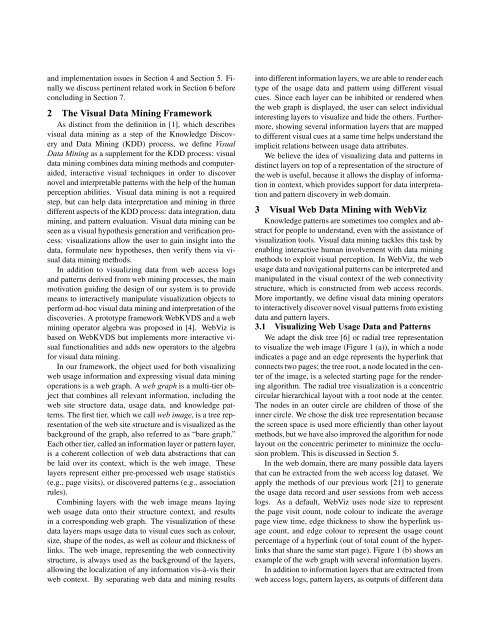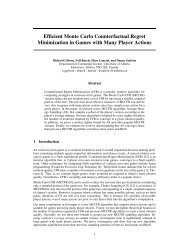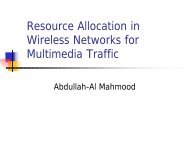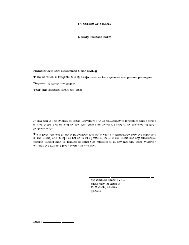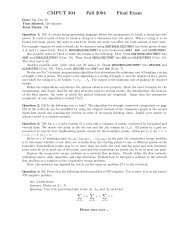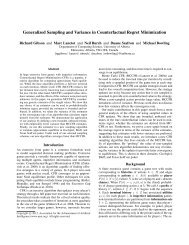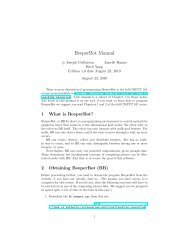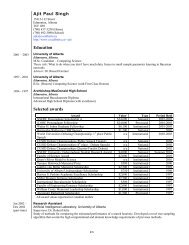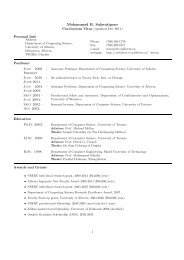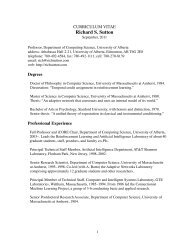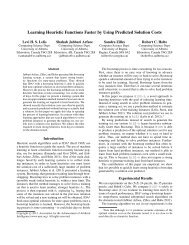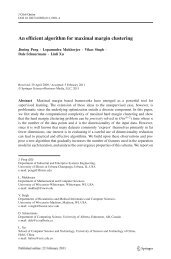Visual Data Mining of Web Navigational Data - Make Final Year ...
Visual Data Mining of Web Navigational Data - Make Final Year ...
Visual Data Mining of Web Navigational Data - Make Final Year ...
Create successful ePaper yourself
Turn your PDF publications into a flip-book with our unique Google optimized e-Paper software.
and implementation issues in Section 4 and Section 5. <strong>Final</strong>ly<br />
we discuss pertinent related work in Section 6 before<br />
concluding in Section 7.<br />
2 The <strong>Visual</strong> <strong>Data</strong> <strong>Mining</strong> Framework<br />
As distinct from the definition in [1], which describes<br />
visual data mining as a step <strong>of</strong> the Knowledge Discovery<br />
and <strong>Data</strong> <strong>Mining</strong> (KDD) process, we define <strong>Visual</strong><br />
<strong>Data</strong> <strong>Mining</strong> as a supplement for the KDD process: visual<br />
data mining combines data mining methods and computeraided,<br />
interactive visual techniques in order to discover<br />
novel and interpretable patterns with the help <strong>of</strong> the human<br />
perception abilities. <strong>Visual</strong> data mining is not a required<br />
step, but can help data interpretation and mining in three<br />
different aspects <strong>of</strong> the KDD process: data integration, data<br />
mining, and pattern evaluation. <strong>Visual</strong> data mining can be<br />
seen as a visual hypothesis generation and verification process:<br />
visualizations allow the user to gain insight into the<br />
data, formulate new hypotheses, then verify them via visual<br />
data mining methods.<br />
In addition to visualizing data from web access logs<br />
and patterns derived from web mining processes, the main<br />
motivation guiding the design <strong>of</strong> our system is to provide<br />
means to interactively manipulate visualization objects to<br />
perform ad-hoc visual data mining and interpretation <strong>of</strong> the<br />
discoveries. A prototype framework <strong>Web</strong>KVDS and a web<br />
mining operator algebra was proposed in [4]. <strong>Web</strong>Viz is<br />
based on <strong>Web</strong>KVDS but implements more interactive visual<br />
functionalities and adds new operators to the algebra<br />
for visual data mining.<br />
In our framework, the object used for both visualizing<br />
web usage information and expressing visual data mining<br />
operations is a web graph. A web graph is a multi-tier object<br />
that combines all relevant information, including the<br />
web site structure data, usage data, and knowledge patterns.<br />
The first tier, which we call web image, is a tree representation<br />
<strong>of</strong> the web site structure and is visualized as the<br />
background <strong>of</strong> the graph, also referred to as “bare graph.”<br />
Each other tier, called an information layer or pattern layer,<br />
is a coherent collection <strong>of</strong> web data abstractions that can<br />
be laid over its context, which is the web image. These<br />
layers represent either pre-processed web usage statistics<br />
(e.g., page visits), or discovered patterns (e.g., association<br />
rules).<br />
Combining layers with the web image means laying<br />
web usage data onto their structure context, and results<br />
in a corresponding web graph. The visualization <strong>of</strong> these<br />
data layers maps usage data to visual cues such as colour,<br />
size, shape <strong>of</strong> the nodes, as well as colour and thickness <strong>of</strong><br />
links. The web image, representing the web connectivity<br />
structure, is always used as the background <strong>of</strong> the layers,<br />
allowing the localization <strong>of</strong> any information vis-à-vis their<br />
web context. By separating web data and mining results<br />
into different information layers, we are able to render each<br />
type <strong>of</strong> the usage data and pattern using different visual<br />
cues. Since each layer can be inhibited or rendered when<br />
the web graph is displayed, the user can select individual<br />
interesting layers to visualize and hide the others. Furthermore,<br />
showing several information layers that are mapped<br />
to different visual cues at a same time helps understand the<br />
implicit relations between usage data attributes.<br />
We believe the idea <strong>of</strong> visualizing data and patterns in<br />
distinct layers on top <strong>of</strong> a representation <strong>of</strong> the structure <strong>of</strong><br />
the web is useful, because it allows the display <strong>of</strong> information<br />
in context, which provides support for data interpretation<br />
and pattern discovery in web domain.<br />
3 <strong>Visual</strong> <strong>Web</strong> <strong>Data</strong> <strong>Mining</strong> with <strong>Web</strong>Viz<br />
Knowledge patterns are sometimes too complex and abstract<br />
for people to understand, even with the assistance <strong>of</strong><br />
visualization tools. <strong>Visual</strong> data mining tackles this task by<br />
enabling interactive human involvement with data mining<br />
methods to exploit visual perception. In <strong>Web</strong>Viz, the web<br />
usage data and navigational patterns can be interpreted and<br />
manipulated in the visual context <strong>of</strong> the web connectivity<br />
structure, which is constructed from web access records.<br />
More importantly, we define visual data mining operators<br />
to interactively discover novel visual patterns from existing<br />
data and pattern layers.<br />
3.1 <strong>Visual</strong>izing <strong>Web</strong> Usage <strong>Data</strong> and Patterns<br />
We adapt the disk tree [6] or radial tree representation<br />
to visualize the web image (Figure 1 (a)), in which a node<br />
indicates a page and an edge represents the hyperlink that<br />
connects two pages; the tree root, a node located in the center<br />
<strong>of</strong> the image, is a selected starting page for the rendering<br />
algorithm. The radial tree visualization is a concentric<br />
circular hierarchical layout with a root node at the center.<br />
The nodes in an outer circle are children <strong>of</strong> those <strong>of</strong> the<br />
inner circle. We chose the disk tree representation because<br />
the screen space is used more efficiently than other layout<br />
methods, but we have also improved the algorithm for node<br />
layout on the concentric perimeter to minimize the occlusion<br />
problem. This is discussed in Section 5.<br />
In the web domain, there are many possible data layers<br />
that can be extracted from the web access log dataset. We<br />
apply the methods <strong>of</strong> our previous work [21] to generate<br />
the usage data record and user sessions from web access<br />
logs. As a default, <strong>Web</strong>Viz uses node size to represent<br />
the page visit count, node colour to indicate the average<br />
page view time, edge thickness to show the hyperlink usage<br />
count, and edge colour to represent the usage count<br />
percentage <strong>of</strong> a hyperlink (out <strong>of</strong> total count <strong>of</strong> the hyperlinks<br />
that share the same start page). Figure 1 (b) shows an<br />
example <strong>of</strong> the web graph with several information layers.<br />
In addition to information layers that are extracted from<br />
web access logs, pattern layers, as outputs <strong>of</strong> different data


